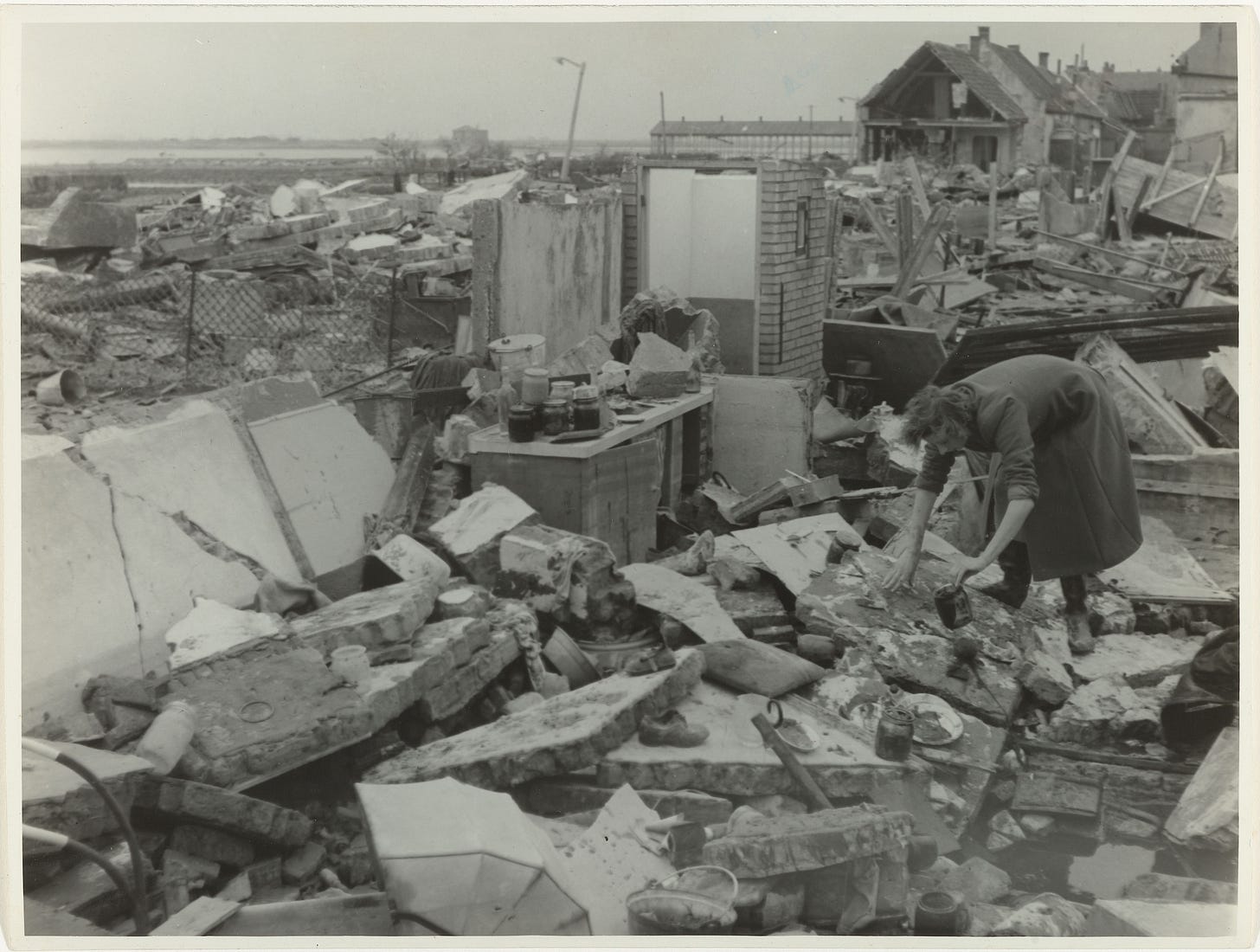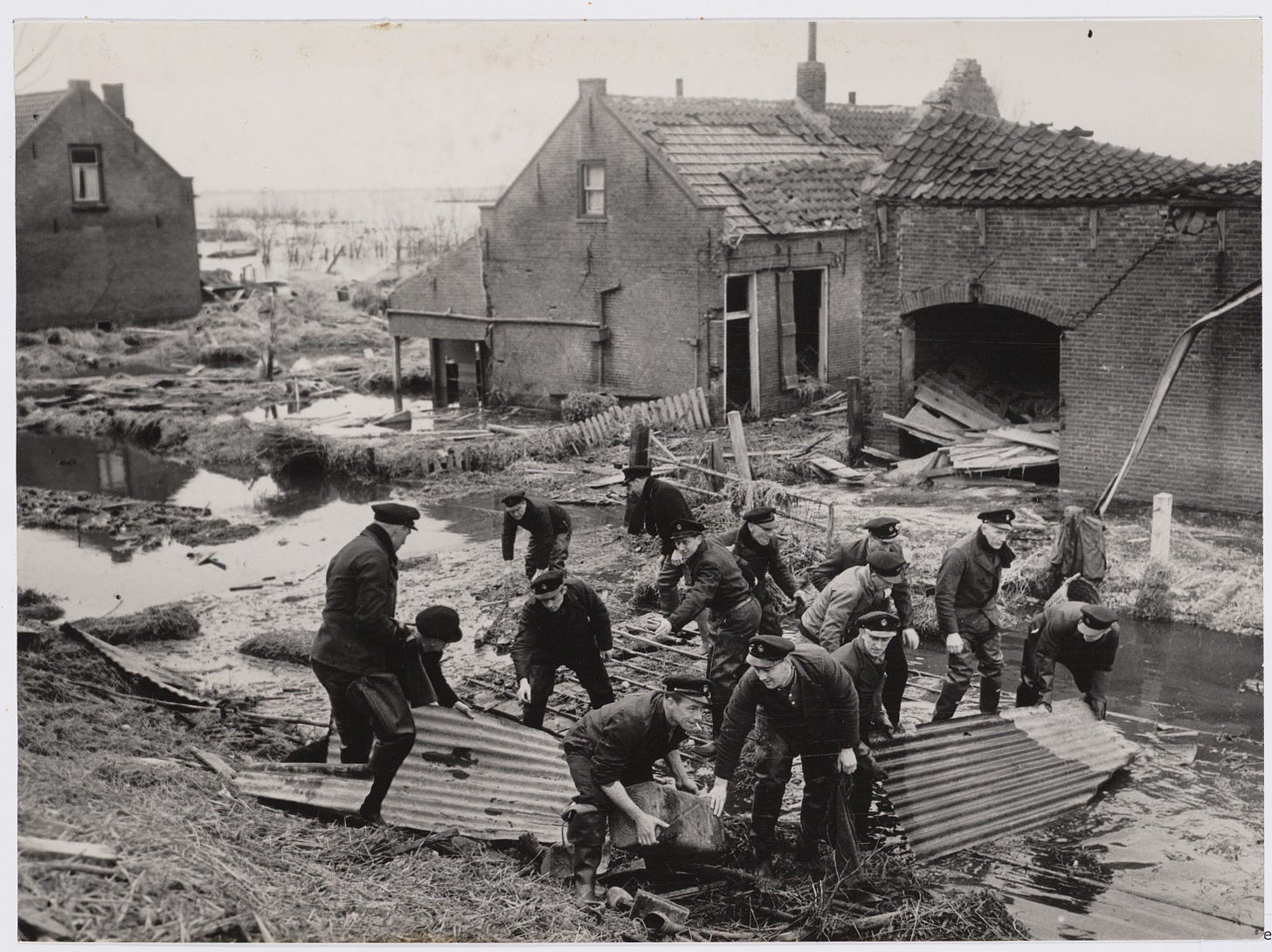After the Texas Floods: A Dutch Perspective
How the Netherlands transformed tragedy into protection—lessons America can't ignore
The night of January 31, 1953, began like any other Saturday in Zeeland. Families gathered around their radios, children played their final games before bed, and the traditional way of life in the mostly agricultural southwestern province continued as it had for generations. By dawn on February 1, 1953, that world was gone.
A catastrophic storm surge had caused more than 150 dike breaches across Zeeland, South Holland, and North Brabant. Within hours, seawater covered 150,000 hectares of land. In the village of Oude-Tonge alone, 305 people drowned. Twenty-year-old Jos de Boet lost 42 family members in a single night. Across the disaster zone, 1,836 people perished, swept away by what the Dutch call the 'watersnoodramp'.
I know this story not just from history books, but from the land itself. My family roots are in Zeeland, and I now live on the same island where eleven generations ago my ancestors already lived. The flood that took so many lives also shaped the province where my roots run deepest. What happened next, in the weeks and years following that terrible February morning, offers a relevant lesson for America as it grapples with its own water disasters.
This past week, as I watched the shocking images from Texas Hill Country, it made me think about my homeland's response to catastrophe. The Guadalupe River had surged 26 feet in less than an hour, killing at least 120 people and leaving more than 160 missing. At Camp Mystic, an all-girls Christian summer camp, 27 campers and counselors died as cabins along the riverbank were swept away. Like the Dutch victims of the 1953 flood, many were asleep when the water came.
However, the parallels are fundamentally different from those seen in Texas after water disasters occur. Despite being located in what experts call "Flash Flood Alley," a region with a long history of deadly flooding, insufficient action was taken over the decades to prevent a repeat disaster.
In stark contrast to what we've seen so far in Texas, the Netherlands had, within weeks of the Dutch disaster, established the Delta Commission. The ambitious Delta Plan was accepted in 1957, one of the most revolutionary engineering projects in the world. Under the motto "The shorter the coastline, the easier the defense," the plan shortened the Dutch coastline by 700 kilometers. Massive investments followed: the Eastern Scheldt Barrier, just minutes from my home village, and the Maeslant Barrier, both marvels of engineering that form part of an entire system designed to ensure such a tragedy could never happen again.
Our coastal defenses had been neglected during the war and in the subsequent years of economic hardship when the government prioritized investment in housing and other infrastructure projects. We were aware that the dikes were not in the state they should be in. The flood took the lives of 1,836 people, 47,000 cattle, and 140,000 poultry. Many people were caught unprepared because, in those days, there was no warning system to alert people. The Dutch government's response was immediate and comprehensive: if people had died because the warnings failed and the defenses crumbled, then both would be rebuilt better than before.
The results speak for themselves. Since 1953, the Netherlands has never experienced flood casualties on a scale remotely approaching that. The Delta Project, designed to reduce the threat of flooding in Zeeland and other critical areas to a once-in-10,000-year event, has been called one of the seven wonders of the modern world.
In Texas, the story unfolds differently. Kerr County and its surrounding counties are part of what is known as 'Flash Flood Alley,' a region in Texas with a long history of flash flood events. This wasn't the first time deadly floods had struck the area. In 2002, twelve people died in similar flooding in Hill Country. Twenty-three years later, lessons remained unlearned.
Consider the warning systems. Twenty-two warnings from the National Weather Service were issued for Kerr County regarding the storms and flash flooding, and the language used by the service escalated over time. But some local residents said they did not receive emergency alerts on their phones nor did they understand how serious the situation had truly become until it actually happened. Despite being in "Flash Flood Alley," Kerr County had debated installing flood sirens for years but failed to act due to cost concerns. The price tag was approximately $1 million. Considering the horrendous events that have now taken place, the cost of installing flood sirens would have been negligible compared to the scale of the disaster. We're not talking about the Delta Works here; it's only just some flood sirens.
The federal response revealed further cracks. Among those who left was Paul Yura, who had been the warning coordination meteorologist at the NWS's Austin/San Antonio office. Yura spent more than half of his 32-year career in the office and took an early retirement offer in April, part of the Trump administration's cost-cutting measures. This key position coordinates with local emergency management officials and serves as the public face of the office during crises. The flooding occurred amid concerns about staffing levels at the National Weather Service, following the Trump administration's firing of hundreds of meteorologists this year as part of budget cuts. While officials insisted forecasting offices operated normally, the union representing NWS workers reported 10 vacant positions between the San Antonio and San Angelo offices that cover the affected areas.
More troubling still was the pattern of building in known danger zones. Camp Mystic was situated directly along the Guadalupe River in an area known for its susceptibility to flash flooding. A state inspector had visited just two days before the floods and noted the camp had "a written plan for responding to natural disasters." Still, the plan apparently didn't include evacuation to higher ground, unlike at least one other camp on the same river. Most disturbing of all, records show that FEMA had repeatedly granted appeals from Camp Mystic to remove dozens of its buildings from flood hazard maps; first 15 buildings in 2013, then 15 more in 2019 and 2020. As Syracuse University professor Sarah Pralle noted, it was "particularly disturbing" that a camp responsible for so many young lives would seek exemptions from basic flood regulation. "It's a mystery to me why they weren't taking proactive steps to move structures away from the risk," she said.
I often return to the beautiful province of Zeeland, which I consider my true home, and see the physical manifestation of a society that decided government exists to protect its people. The Delta Works are everywhere: massive barriers and storm surge gates that represent not just engineering prowess but political will. The Dutch understood already in 1953 that you cannot solve catastrophic flooding with individual responsibility or market solutions. You need collective action, long-term investment, and a government willing to spend what it takes to keep people safe.
The Delta Works brought other benefits too. We now have world-renowned expertise in water management that gets exported worldwide.
It also brought jobs, and by connecting all these islands by dams and bridges, we opened up the province. It has been a significant boost to the economy of this previously remote and agricultural province. Those dams that have been built serve a dual purpose: first, they provide protection, but they are now also a magnet for tourism. If you visit now, you will see a variety of water sports, music festivals, bars, restaurants, and holiday parks along these dams. It has contributed immensely to modernizing the entire province and enhancing its connectivity with the rest of the country.

I believe it's essential how societies choose to remember their disasters. On the eastern side of the island where I live in the Netherlands, we built the Watersnoodmuseum to ensure future generations understand both the human cost of the 1953 flood and the importance of the defenses built in its aftermath. Every February 1, we observe the Herdenking Watersnoodramp, commemorating the water disaster. I was present there last year, and I listened to several survivors who were children during those days and are now in their eighties. They were telling about their experiences one after the other with their strong local accents and their voices still full of emotion about the shock and horror of seeing their family members drown while they themselves were floating on the roofs of their houses. It felt a bit like time traveling through history, seeing those people, and still feeling the pain they carried from what happened then.
In the United States, collective memory appears to function differently. The Hill Country flood death toll is higher than the total number of flood-related deaths recorded across the country last year, along with the year before. Yet the response follows a familiar pattern: emergency declarations, rescue operations, and what will likely follow is rebuilding in the same vulnerable locations, with the hope that next time will somehow be different.
The human cost accumulates differently too. In Zeeland, we counted 1,836 dead and decided that number was unacceptable and that the government had failed in its most basic duty. In Texas, where more than 120 have died and over 160 remain missing, the debate centers not on preventing future disasters but on who's to blame for the current one. Governor Abbott dismissed such questions as "the word choice of losers," saying "championship teams" focus on response rather than accountability. President Trump showed similar defensiveness when asked whether more lives could have been saved if flood warnings had been received earlier, lashing out at the reporter: "Only a very evil person would ask a question like that." The quality of disaster response suffers when political considerations override the willingness to learn from past mistakes; a pattern evident in the stark contrast between Trump's supportive response to Texas, a red state that voted for him, and his blame-focused approach to California's recent wildfires under Democratic leadership.
But here's what seventy years of Dutch experience teaches: championship teams don't see rescue and prevention as competing priorities. They rescue people in the immediate crisis and then build systems to prevent the crisis from recurring. We weren't shy about investigating what went wrong; that was essential to preventing it from happening again.
My father, a young doctor at the time, heard about the disaster on the radio the next morning and immediately headed south to join one of the small boats evacuating survivors from the rooftops. Like so many others, he understood that individual responsibility in rescue was only the beginning; the real work lay in ensuring such personal acts of courage would never again be necessary.
As a writer from Europe, I am returning to a simple truth that seems evident from a European perspective but is increasingly controversial in America: you need government to take measures. The free market didn't build the Delta Works. Individual preparedness couldn't have saved Oude-Tonge. Only collective action, sustained over decades and backed by massive public investment, has transformed the Dutch relationship with water from one of periodic catastrophes to one of confident management.
The technology exists. The expertise is available; much of it was originally developed in the Netherlands after 1953. What seems to be missing is the political will to treat flooding not as an act of God to be endured but as a problem to be solved.
Climate change will exacerbate these challenges. Recently, there were at least four 1-in-1,000-year rainfall events across the United States in less than a week; intense deluges that are thought to have roughly a 0.1% chance of occurring in any given year. Meteorologists say the area has been under extreme drought conditions, which have only exacerbated the flooding. Dry, parched soil cannot absorb a deluge of water quickly and becomes overwhelmed, leading to flash flooding. Climate change intensifies both droughts and flooding because a warmer climate can extend both intense dry spells and extreme precipitation.
The Trump administration's approach to climate science represents a fundamental rejection of the collective action that catastrophic flooding demands. As the ProPublica analysis notes, we're now in "an age of climate-driven chaos, where the past is no longer prologue." The number of extreme weather disasters has increased fivefold worldwide over the past 50 years, yet, the U.S. response has been to withdraw from the Paris Climate Agreement despite the country experiencing an unprecedented surge in extreme weather events. This reflects a troubling unwillingness to accept responsibility for a crisis America has contributed to more than any other nation through its historic greenhouse gas emissions. Meanwhile, the administration has simultaneously gutted the very agencies—NOAA, the National Weather Service, and FEMA—that help communities prepare for and respond to these increasingly severe events.
In the Netherlands, we're already adapting our Delta Works for rising sea levels and changing weather patterns. The approach has evolved from rigid defenses to "building with nature," flexible systems that work with water rather than simply blocking it. We're planning for the next century, not just the next election cycle.
America could do the same. The expertise exists. The technology is proven. What's needed is the political courage to invest in prevention rather than just response, to build systems that save lives rather than count the dead. Even basic disaster response infrastructure has been compromised: FEMA missed thousands of calls from flood victims because call center contracts had expired, with Homeland Security Secretary Kristi Noem waiting five days to renew them due to new bureaucratic approval requirements she had instituted.
As rescue teams continue searching through the debris along the Guadalupe River, finding the bodies of children and counselors, I think about Jos de Boet, who lost 42 family members in 1953. His tragedy and those of so many others helped galvanize a nation to ensure such losses would never happen again. The question for America is whether the 120 dead in Texas will inspire similar resolve or whether they'll become just another entry in the growing ledger of preventable disasters.
Seventy-two years after Zeeland's catastrophe, the answer to that question will reveal not just America's relationship with water but also its willingness to learn from history and from the hard-won wisdom of places that have faced rising waters and chosen to fight back with everything a government can offer its people.
In Texas, the waters have receded, but the choices remain. All over the United States, new weather-related disasters loom as hurricane season approaches, and the next flood may already be building somewhere upstream.
If this kind of international perspective on American challenges resonates with you, consider becoming a paid subscriber to The Planet. Your support helps me continue bringing European insights to American crises—and there will be many more to analyze in the years ahead.
Or perhaps you liked the article and want to support my writing by buying me a coffee?
When I travel, there is often something extra to enjoy on Patreon:
I also write the daily newsletter Daybreak Notes & Beans, where I share positive news and stories that restore faith in human potential, rather than reinforcing daily despair, as most other media do. As an example, here is today’s Daybreak Notes & Beans:










This is a remarkable account of two parallel disasters. Texas government will do their best to assign blame and walk away from the responsibility of prevention. The images you found of the Dutch tragedy are profound. Thank you for sharing them.
"What seems to be missing is the political will to treat flooding not as an act of God to be endured but as a problem to be solved."
I fear we are entrenched in exactly this issue. The Christian right and MAGA ignore science and the necessity of providing action, investment, funding to remedy catastrophy and prevent further disasters.